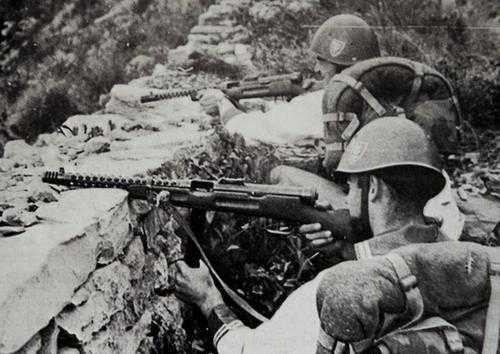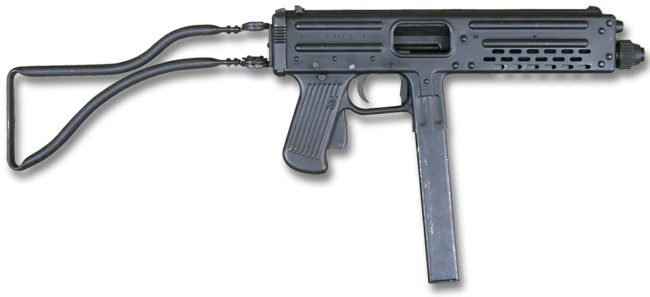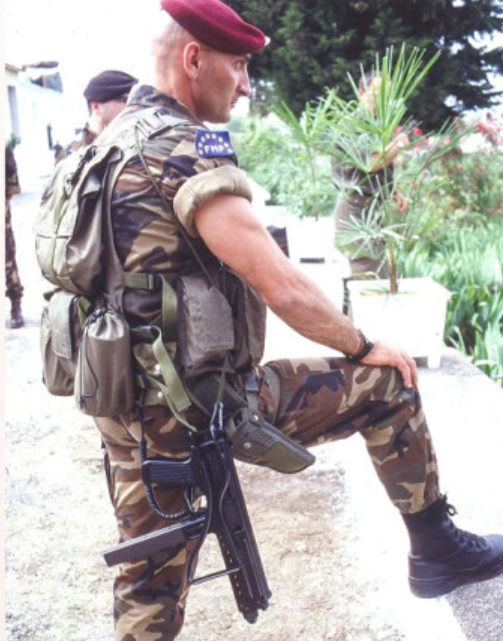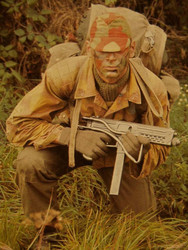The LF-57 Sub-machinegun: Franchi's fascinating first.
Posted by Dan the Man :D on Jan 22nd 2025

Image (1): Two LF-57s side by side with extended stocks.
The makings of a saint:
The saying that there's "no such thing as an atheist in a foxhole" is an oft remarked sentiment almost omnipresent in our war-themed media. To the Portuguese soldiers and "men of fortune" operating in the war-torn battlegrounds of 1960s Angola and Congo, it manifested in a very pragmatic sense. The soldier pictured above holds his ecclesiastical devotion in his very own hands: the "Saint Luigi" LF-57 submachine gun. This SMG was known to always run reliably no matter what, providing soldiers of multiple fronts one thing to rely on when all else failed.
The story of the "saintly" LF-57 is an incredibly intriguing one that will require us to delve into the LF-57's precursors of World War Two that led Luigi Franchi to create his sub-gun the way he did. I'll be caveating all of this with the fact that sources are VERY limited and seeing as I don't speak Italian (also known as third-best Italian) or live inside any rural Italian countryside libraries, I'll be doing my best to paint as complete a picture as possible with the few sources I do have. With all that said grab your closest pizza/pasta meal, put on the Warren Zevon classic "Roland the Headless Thompson Gunner" and pour yourself a nice steep glass of Italian box wine and let's get into some history!
Sub-guns of the 1940s:
The pioneering of the MP18 by the German military in the waning months of World War 1opened pandoras box of sub-machine guns. No longer were soldiers forced to choose between bulky slow-firing bolt-action rifles and extremely heavy machine-guns. Now groups of soldiers were able to use fast firing "sub" machine-guns as deadly force multipliers. Some groups like the Finns with their KP-31 found marked success in their development and tactical use during their Winter war against the Soviet Union. Soviet soldiers armed with bolt-action Mosin-Nagant rifles found themselves outgunned against smaller groups Finnish ski troops raking them with fast firing sub-machine guns.
Others found less success due to lack of interest or materials in the concept, like the Imperial Japanese. Their military notably lagged in the use and development of their SMGs, having to largely rely on Italian imports for a time. The Italian sub-machine guns supplied to the Japanese displayed many design decisions that would directly affect the development of the LF-57 or be outright utilized in the LF-57.
 Image (2): Italian soldiers at the ready with Beretta Model 38s.
Image (2): Italian soldiers at the ready with Beretta Model 38s.
For as much flak as the Italians deservedly receive for their lack-luster military conduct during World War Two, they had a few redeeming qualities. One of the more prolific of which being the mass production of the Beretta Model 38 sub-machine gun. This bad boy armed the Italian, German, and Argentinian militaries, with it also seeing service among various partisan groups. Chambered in 9x19 with 10, 20, 30, & 40 round magazines the MAB 38 became the quintessential "Italian soldier's" firearm right next to the Carcano rifle.
As the war ground on and the Italian countryside became a battleground split between the Italian government aligned with the Allies in the South and Mussolini's fascist puppet Republic of Salo in the North. This Republic was very short-lived but was able to manufacture a few last-ditch SMGs that would be used as direct inspiration for the LF-57. Although these designs weren't produced in nearly as many copies as the Beretta 38, they would end up influencing the makeup of our saintly pancake: The LF-57.
Luigi enters the fray:
By the end of the war, the world at-large knew SMGs were great for close-range fast-moving infantry to flush out enemy positions and achieve fire superiority. Practically everyone had their own designs they were mass equipping their troops with. The concept of the "assault rifle" was gaining popularity, but a market was still wide-open for compact sub guns post-1945.Thus, the beginning years of the Cold War were marked with a host of wacky SMG designs flooding the market. Against this chaotic backdrop, one Luigi Franchi decided to unveil his first firearm ever released, the LF-57 blowback operated sub-machine gun chambered in 9x19.

Image (3): A radio operator of the Aquileia unit crouches LF-57 in hand.
The LF-57 checked off many of the requirements of SMGs on the market at the time. Weighing eight pounds fully loaded with the stock extended, it was a compact firearm measuring two feet long in totality. This portable nature was vital to sub-machine guns at the time as they found themselves used more by units focused on operating in cramped urban environments.
The 57' was an extremely simple design, consisting of two pieces of sheet metal being smacked together internally covering one another which were then welded into place and reinforced with rivets. Interestingly, this design meant there was no separate grip or mag well, as the two pieces of metal being bent together formed these pieces. Creating an SMG out of pancaking sheet metal together has its pros, mainly a very low cost of manufacture.

Image (4): LF-57 side view, note the rivets the reinforcing the receiver.
Adding to its low manufacture cost, it was a very safe firearm utilizing a grip safety, along with a front safety block preventing firing unless the shooter is ready. It was initially designed exclusively for full-automatic fire, however a fire-selector switch was later implemented to allow for single shots as well. As far as SMGs go, it's interesting that it was fairly accurate due to the positioning of the recessed bolt assembly over the barrel. This was very reminiscent of the OG-43 manufactured in very low numbers by the Fascist Italians in the last year of the war. Sidenote, the OG-44 looks absolutely ridiculous, and I love it.

Image (5): OG-44 side view, note the bolt assembly tube above the barrel.
The increased weight above the barrel aided in keeping the bursts on target. This is most easily contrasted by comparing it to its primary market adversary the Beretta M12, which situated the bolt to the side of the barrel instead. Either way, I personally feel that developing firearms in the 1950s required you to make everything look as ridiculous as possible. In this aspect, the LF-57 certainly succeeds by leaps and bounds.
The LF-57 in action:
So how was Franchi's creation received by the Italian military he attempted to contract it to? They shrugged and said sure, but no thanks. Beretta had a stranglehold on the market due to their previous decades of mass producing the MAB 38, and the military and police forces largely stuck to the updated M12 for their submachine-gun use.
The LF-57 did see a singular limited contract to arm the Aquileia Missile Brigade before the M12 took hold, and by all accounts the LF was reasonably well-liked by the soldiers that used it. The lack of domestic success is a bit of a mystery, but one potential reason is the proliferation of other SMGs such as the MAT-49, M12, Carl Gustaf, Sterling, and the list goes on, but I won't belay the point. There were also a few downsides to the LF-57, notably the lack of a lock when the stock was fully extended. This would create a tendency for the stock to wobble during operation, lowering the potential accuracy of the firearm. The sights themselves were also not protected and due to the dove-tail mounts could be easily damaged via extensive use in the field.

Image (6): An Italian soldier takes a knee with his LF-57 hanging from his rig.
Although the LF-57 didn't see commercial success in Italy, their initial contract did help them to sell the Portuguese military on a contract for a further ten thousand models to equip their troops fighting in Angola and Mozambique. This contract represented a full third of the models created for the export market, and their proliferation largely ended up in the hands of groups fighting in the Bush wars of Congo, Angola, and Mozambique. It initially equipped Portuguese soldiers and white mercenaries fighting in the region being favorably received, with soldiers reflecting on its ease of use, accuracy, and simplicity. This is likely where it earned it's "San Luigi" nickname. After all, if I'm picking a firearm to saint it better be reliable and at least a little wacky!
Video (1): LF-57 fired in short bursts. Credit to Armi e Tiro
All-together 30,000 LF-57s were manufactured for foreign export with production finally coming to a conclusion in 1980.Was it the hit SMG that Franchi wanted it to be? Absolutely not. Was it a decent design that could compete with the other SMGs of its time? Yeah, I'd say so. It also made it into Call of Duty so hey that's better than lots of obscure sub guns out there! For further reading please consult my sources listed below. There are some brief manuals online, however you may need to purchase physical books for a more detailed analysis of the LF-57.
If you want to check these out for yourself be sure to peruse our newly arrived LF-57 kits and accessories HERE!
Sources:
Balzi, Vittorio. I Mitra Italiani 1915-1917. Editoriale Olimpia, 1992
Divisione Sistemi Difensivi. Luigi Franchi S.p.A. LF 57.
Hogg, Ian. Military Small Arms of the 20th Century. Krause Publications, 2000.
Poggiali, Luca. Franchi LF-57 “La San Luigi.”

